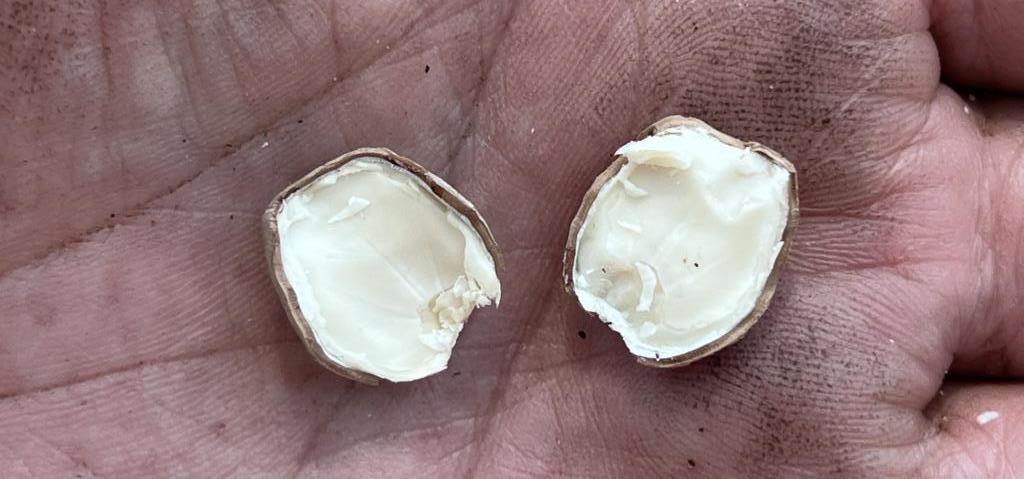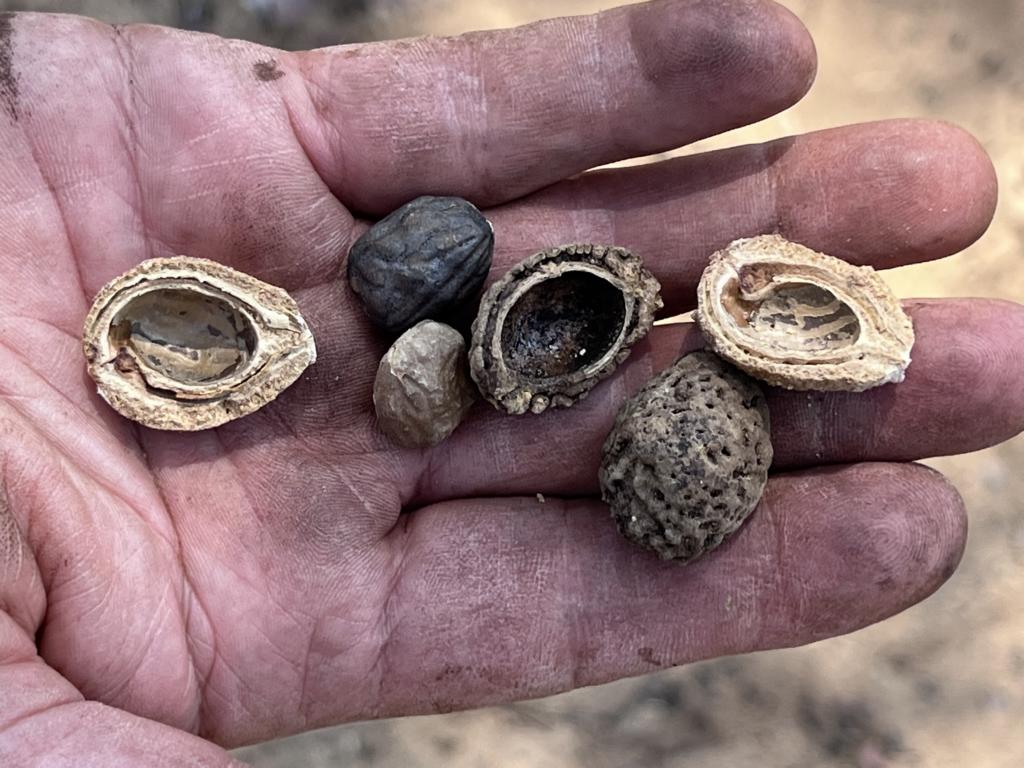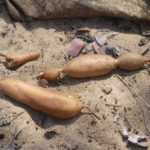Manketti nuts are a staple food for a variety of people within its distribution range. And there is a strict division of naming them. Khoi-san people (Bushmen) call them ‘Manketti’, whereas Kavango people (Bantus) call them ‘Mongongo’. Both names denominate the same trees and nuts.
Whereas Kavangos (the Kavango river and the O’kavango swamps were named after them) live mainly from Mahangu (Pearl millet) porridge, Khoi-sans rely for 8 months a year heavily on Manketti nuts for food.



The Manketti tree (Schinziophyton rautanenii) belongs to the family of Euphorbiacea. There is however no milky sap or poison in any parts, as with many other Euphorbiaceas. Besides, providing delicious nuts, the tree is also important for Khoi-san people (especially Ju/’hoansi) for providing fire sticks. The wood is strong, dense, and very lightweight – similar to Balsa wood. The tree prefers to grow in sandy areas and is one of the most beautiful trees in Southern Africa, due to the golden shimmer of its bark. Distribution ranges from north-eastern Namibia, via northern Botswana, western Zimbabwe, and south-western Zambia.
Harvesting time of Manketti nuts
Nuts ripen from March to May, and some of them start falling, but even until the end of October, some nuts remain on the trees. And that’s very important for Ju/’hoansi people. These nuts are available for 8 months a year and can easily be stored longer without being attacked by insects! The reason for this fact will be described below.


Description of Manketti nuts
Falling Manketti nuts are about 3 x 2 cm in size, oval-shaped, and of a reddish-brownish color with an off-white dusting on it. This outer covering of the nut is an exocarp (fruity layer) of high nutritional value and already acts as a first layer of protection for the inside nut kernel as it gets quite dry and hard to penetrate.
Inside the exocarp is the hard-shelled, pitted nut located. But this nutshell consists of two shells, which are separated by a 1 mm wide bark cushion and only kept to each other by their intrinsic shapes.
Inside this 2nd shell (or more correctly: 3rd shell, as the exocarp is also quite protective) is the nut kernel located – protected by another layer of shell. Also, this layer is very dense and difficult to crack if not done daily.
So, in the end, four layers of protection have to be overcome to get to the final price – a white, fatty nut the size of a hazelnut.
How to open Manketti nuts
Many wild animals like to feed on the exocarp of the nuts. Especially African elephants (Lexodonta africana) and Common duiker (Sylvicapra grimmia). As elephants only digest about 40% of their food, the fruity layers of Manketti nuts will be digested and the hard-kernelled nuts will remain in the dung – a heaven for Ju/’hoansi. Duikers on the other hand like to chew the exocarp and spit out the nut; again, highly sought after by bushmen. To soften the hard outer exocarp, Kavangos like to steam the fruits first and cook them thereafter, and the resulting pulp is eaten. There are two ways now to eat the nuts. Either raw or roasted.
Eating raw nuts
For eating Manketti nuts raw, they will be split in the middle by blows of a pestle and on the turned-over indigenous axe blade. After splitting the two shell layers, the kernel is taken out of these shells and opened with another piece of wood by splitting the layer around the kernel. The taste and texture of this nut are in my opinion very similar to Macadamia nuts with a greenish tinge.


Roasting the nuts
That’s a much simpler way of getting to the nut. Whole Manketti nuts are put into hot sand from a fire and covered again with sand and glowing coals until they are considered done. The exocarp will have been partly burnt and the nut shells can be cracked more easily compared to raw nuts. The taste of the nuts changed now to roasted peanuts and they also changed texture to a more brittle bite.
Nutritional value of Manketti, respective Mongongo nuts
According to information retrieved on Oct 28th, 2022 from Wikipedia, see here, 100 mg of shelled Manketti nuts have the following contents:
- 24 g protein
- 57 g fat, of which: 44% are polyunsaturated fatty acids; 18% are monounsaturated fatty acids and 17% are saturated fatty acids
- 193 mg calcium
- 527 mg magnesium
- 4 mg zinc
- 2.8 mg copper
- 565 mg vitamin E (tocopherol)
Citation:
A diet based on mongongo nuts is in fact more reliable than one based on cultivated foods, and it is not surprising, therefore, that when a Bushman was asked why he hadn’t taken to agriculture he replied: “Why should we plant, when there are so many mongongo nuts in the world?”
Lee, Richard B. (1968). “What Hunters Do for a Living, or, How to Make Out on Scarce Resources” Man the Hunter. Chicago: Aldine. p. 33. ISBN 978-0-202-33032-7.
Lessons learned about Manketti / Mongongo nuts:
- Manketti / Mongongo nuts are available nearly year-round for food in Southern African countries
- It would be possible to live just a diet of these nuts without detrimental effects
- Opening the nuts, however, needs special skills



